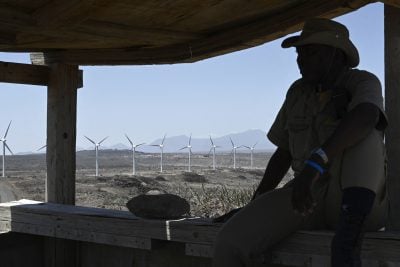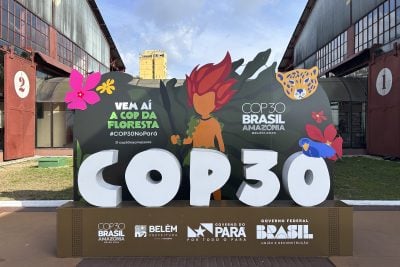The Lake Turkana Wind Power (LTWP) project is both the largest single wind power project in Africa and the largest single private investment in Kenya’s history. It is being developed in Marsabit County, 12km east of Lake Turkana – the biggest permanent desert lake in the world – approximately 530km north of Nairobi, the country’s capital.
The scorching sun is unrelenting, but the blowing winds are strong and they become even stronger after sunset. The sandy soils do not support much in the way of vegetation. Nothing grows here, except for thorny acacia trees which are few and far between.
In this barren and harsh environment stands the village of Sarima, hemmed in by a wire-mesh fence. It is home to 760 families, cobbled together in traditional dwellings known as manyattas, which are made of twigs and other materials.
Villagers derive their livelihood from livestock – sheep, goats and camels – which are nowhere to be seen in the village because they have been driven several kilometres away to look for pasture.
So, when the project came calling, villagers had great expectations for jobs. However, their hopes have since been dampened, with only a handful of jobs to go round. The feeling of bitterness and resentment is widespread.
“I deferred my studies because I had inadequate fees to continue with them,” says Laments Ekomwa, a 20-year-old former student of South Eastern Kenya University.
“I came back to Sarima in January 2015 looking for a job so that I can get money to go back to school but I haven’t gotten a job up to now.”
Benefits
The speed and strength of the winds here place them among the best for power generation in the world. The region has a maximum mean annual speed of 8.47m/s and a minimum of 4.96m/s.
The project is set to generate up to 310MW of power when it comes online towards the end of 2017, contributing 15–20% of Kenya’s energy needs. Besides boosting the country’s power generation, the project remains central to Kenya’s Vision 2030 – a blueprint for development that aims to make Kenya a newly industrialising, middle income nation by 2030.
With its 365 wind turbines, the project will save the country more than $177m a year on fuel imports and benefit approximately 2.5m Kenyans.
It is also registered as a Clean Development Mechanism project under the Kyoto Protocol. This means that the greenhouse gas emissions alleviated by the project can be converted into Certified Emission Reductions (carbon credits) that can be sold to developed countries.
According to the African Development Bank, the project will displace the equivalent of between 565,920 and 1,264,320 tons of carbon dioxide per year. Part of the earnings from carbon trading will be invested in the affected community via the Ministry of Energy.
Opposition
But not everybody is welcoming the project with open arms. The bone of contention lies in the manner in which 150,000 acres of community land was allocated for development. It just so happens that this development is taking place in an area that serves as a vegetation reservoir for pastoralists, where they take their livestock during the dry season, after pasture has been depleted elsewhere. It is also a sacred place for performing traditional rites of passage for the predominant local communities of Rendille, Turkana, Samburu and El Molo.
The community alleges that the defunct Marsabit County Council, (now the Marsabit County Government) allocated land without proper consultations with the community. The issue has since become the subject of a court case. The county government is a co-defendant in the suit alongside LTWP.
And land tenure issues are not the only problem the project has faced. In 2012, the World Bank withdrew its support for the project, citing viability issues arising from a power purchase agreement signed with the country’s power distributor, Kenya Power & Lighting Company (KPLC).
In a letter sent to LTWP project sponsors quoted by the Kenyan newspaper Business Daily, Johannes Zutt, the former World Bank country director for Kenya, stated that the “take-or-pay” provisions in the 20-year agreement would require consumers to pay for excess power generation.
This, he argued, would expose KPLC to “unacceptably large financial risk” and defeat the logic of building a wind farm to reduce the cost of power.
“KPLC’s financial stability is critical to the continuing effort to increase access to electricity in Kenya, and we urge caution in putting unsustainable financial obligation on it,” the newspaper quotes him as saying.
However, in answer to questions raised in the German parliament late last year, the Federal Government of Germany stated that the power project will help push down the cost of power. The German Investment Corporation (DEG) is one of the project lenders.
“The purchase price for the electricity produced by LTWP is below the current national average and as such will contribute to lowering average energy costs,” reads the statement.
Local engagement is key
Land tenure issues are complicated in Africa. According to Aly Khan Satchu, chief executvie officer of Rich Management, an investment advisory service based in Nairobi, investors coming into Africa need to do more to ascertain the risk they are exposing themselves to.
He cites yet another wind power project in Kenya – the 60MW Kinangop Wind Park project, which had to close down due to similar issues facing the LTWP.
“I think that what we find increasingly in so many different parts of our economy is that a lot of international investors haven’t really done their due diligence or they have not been able to measure this kind of risk,” says Satchu.
As far as he is concerned, failure to engage with the local community is a major impediment for investing on the continent.
Geoffrey Kamadi
Want to continue reading? Subscribe today.
You've read all your free articles for this month! Subscribe now to enjoy full access to our content.
Digital Monthly
£8.00 / month
Receive full unlimited access to our articles, opinions, podcasts and more.
Digital Yearly
£70.00 / year
Our best value offer - save £26 and gain access to all of our digital content for an entire year!
 Sign in with Google
Sign in with Google 


